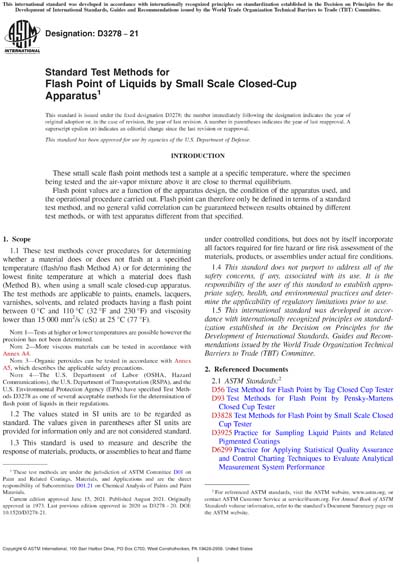Most recent
ASTM D3278-21
Standard Test Methods for Flash Point of Liquids by Small Scale Closed-Cup Apparatus
1.1These test methods cover procedures for determining whether a material does or does not flash at a specified temperature (flash/no flash Method A) or for determining the lowest finite temperature at which a material does flash (Method B), when using a small scale closed-cup apparatus. The test methods are applicable to paints, enamels, lacquers, varnishes, solvents, and related products having a flash point between 0 °C and 110 °C (32 °F and 230 °F) and viscosity lower than 15 000 mm2/s (cSt) at 25 °C (77 °F).
Note 1:Tests at higher or lower temperatures are possible however the precision has not been determined.
Note 2:More viscous materials can be tested in accordance with Annex A4.
Note 3:Organic peroxides can be tested in accordance with Annex A5, which describes the applicable safety precautions.
Note 4:The U.S. Department of Labor (OSHA, Hazard Communications), the U.S. Department of Transportation (RSPA), and the U.S. Environmental Protection Agency (EPA) have specified Test Methods D3278 as one of several acceptable methods for the determination of flash point of liquids in their regulations.
1.2The values stated in SI units are to be regarded as standard. The values given in parentheses after SI units are provided for information only and are not considered standard.
1.3This standard is used to measure and describe the response of materials, products, or assemblies to heat and flame under controlled conditions, but does not by itself incorporate all factors required for fire hazard or fire risk assessment of the materials, products, or assemblies under actual fire conditions.
1.4This standard does not purport to address all of the safety concerns, if any, associated with its use. It is the responsibility of the user of this standard to establish appropriate safety, health, and environmental practices and determine the applicability of regulatory limitations prior to use.
1.5This international standard was developed in accordance with internationally recognized principles on standardization established in the Decision on Principles for the Development of International Standards, Guides and Recommendations issued by the World Trade Organization Technical Barriers to Trade (TBT) Committee.
Content Provider
ASTM International [astm]






